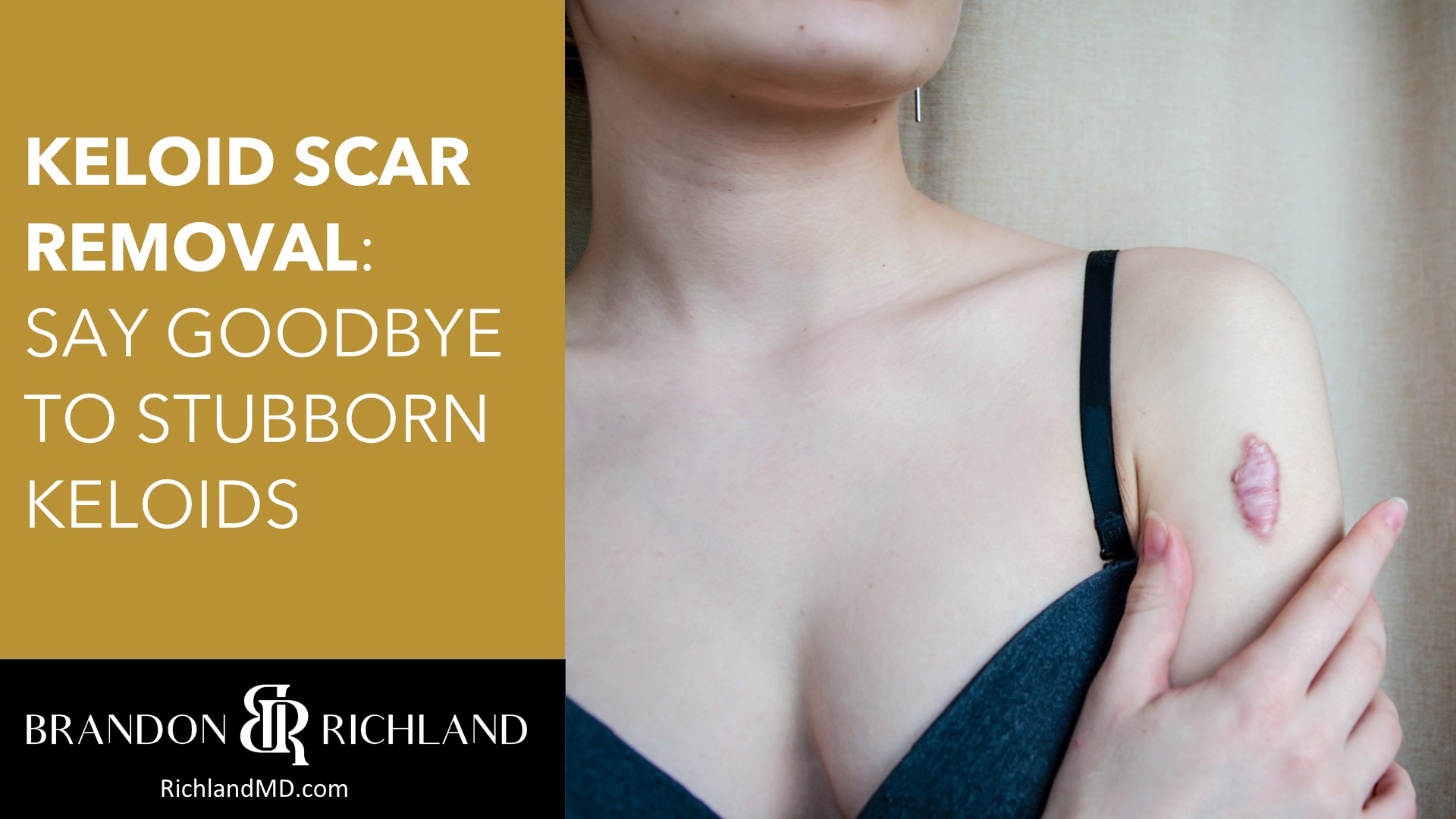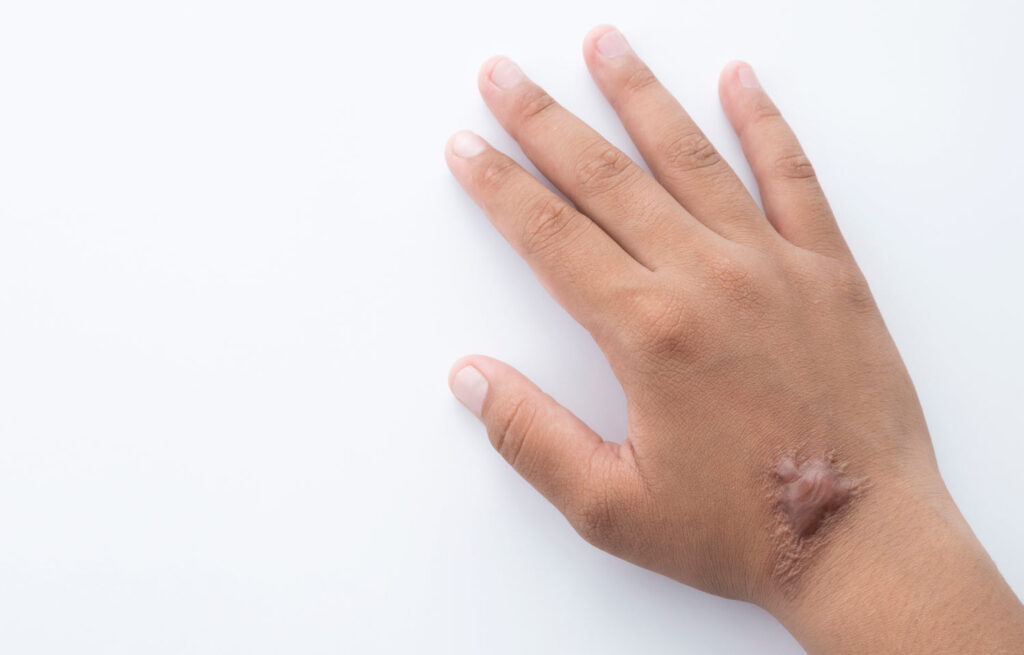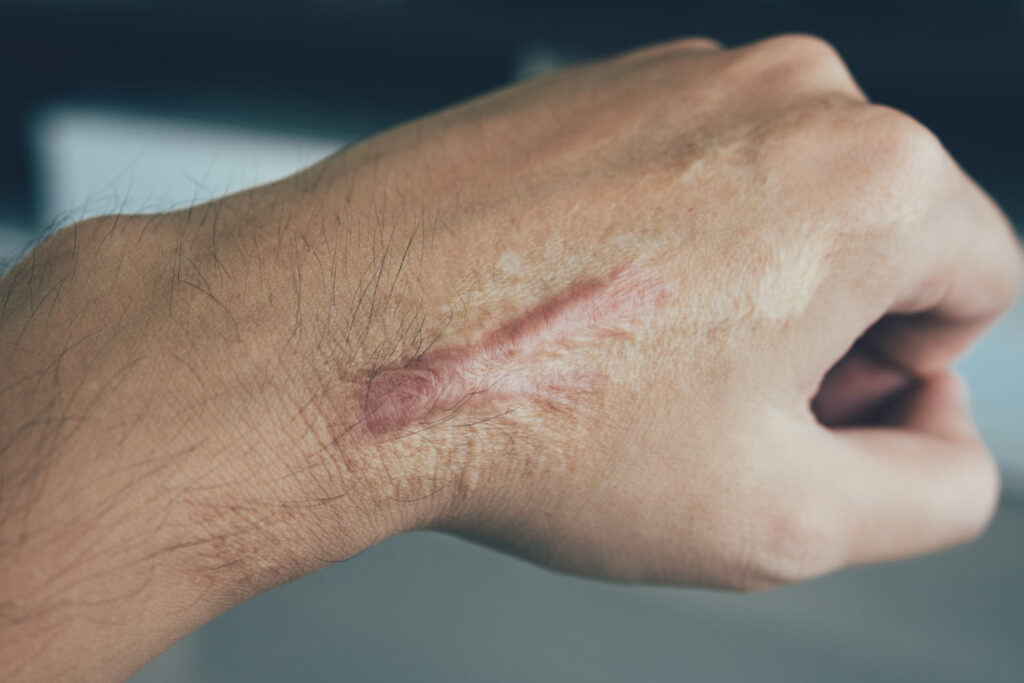Published by Dr. Brandon Richland, MD

Keloid scars are a common but stubborn type of scar that can cause frustration and embarrassment. These thick, raised scars form where the skin has healed after an injury, and they can seem nearly impossible to get rid of. Exploring effective treatments can help reduce or even remove keloid scars for smoother skin.
Keloids can form from various skin injuries, such as piercings, surgeries, acne scars, or even minor cuts. They are more than just a cosmetic concern; keloids can be itchy, uncomfortable, and impact self-esteem. It’s important to know that options range from professional treatments, like corticosteroid injections and silicone gels, to at-home remedies including honey and aspirin pastes.
For those struggling with keloids, finding the right approach may take some trial and error. Consulting with a dermatologist can provide guidance on the most effective keloid treatment options tailored to your skin type and scar characteristics. This post delves into various methods to manage and reduce keloid scars, empowering you with the knowledge to choose the best path for your skin.
Key Takeaways of Keloid Scar Removal
- Effective treatments and home care can help reduce keloid scars.
- Keloids can be itchy and affect self-esteem.
- Dermatologists provide tailored treatment options.
Understanding Keloids
Keloid scars form due to an overgrowth of scar tissue and can be triggered by various skin injuries. Recognizing symptoms and knowing the causes of keloid formations can help in managing them effectively.

What Are Keloid Scars?
Keloid scars are raised, thickened areas of skin that form when the body produces too much collagen during the healing process. They often extend beyond the edges of the original wound. Unlike normal scars, keloids do not regress over time and can continue to grow. This growth creates a smooth, hard texture that can be red or purple. They might cause pain, itchiness, or discomfort. Keloids commonly appear on the chest, shoulders, earlobes, and cheeks but can develop anywhere on the body.
Causes of Keloid Formation
Keloid formation occurs due to an overproduction of collagen after a skin injury. Aberrant wound healing leads to keloid formation by causing an overproduction of collagen and cytokines, resulting in increased proliferative activity and lower rates of apoptosis in keloidal fibroblasts compared to typical wound healing.
This can happen from surgeries, piercings, burns, or even minor cuts and acne. Genetic factors play a significant role, with a family history increasing the likelihood of developing keloids. People with darker skin tones, such as those of African, Asian, or Latino descent, are more prone to keloid scars. Hormonal changes during puberty or pregnancy can also increase the risk. Though less common, spontaneous keloids can occur without any apparent injury.
Identifying Keloids on Your Skin
Keloids are raised scars that can appear on various parts of the body. Knowing their typical size and shape and how they differ from other types of scars is crucial for proper identification.
Size, Shape, and Location
Keloids can vary in size. They may start small but can grow much larger than the original wound. These scars are usually raised and have a smooth, shiny appearance.
Common places where keloids form include the chest, back, shoulders, earlobes, and neck. Keloids often feel firm to the touch. They make the skin look lumpy or uneven. Shape matters too. Keloids often spread out and become irregular. They may look different from the original wound and can feel itchy or painful as they grow.
Difference Between Keloids and Other Scars
It is important to distinguish keloids from other types of scars. Unlike hypertrophic scars, which stay within the boundaries of the original wound and may fade over time, keloids grow beyond the boundaries of the original wound.
Keloids are often darker or lighter than the surrounding skin. They can continue to grow for months or even years. Other scars, like pitted or atrophic scars, don’t have the raised, lumpy texture of keloids.
Recognizing these differences helps in managing and treating keloid scars properly. Knowing where they typically form and their appearance can guide you in seeking appropriate keloid removal treatments.
Professional Keloid Scar Removal Techniques
There are several professional techniques available for removing keloid scars. These methods vary in approach, from surgical to non-invasive treatments, and aim to reduce or eliminate keloid tissue effectively.
Surgical Removal Options
Surgical removal involves cutting out the keloid tissue, known as keloid surgery. Surgeons often use sutures to close the wounds afterward. This procedure typically takes 30 minutes to an hour, depending on the size and location of the keloid.
After surgery, applying pressure or using silicone sheets can help prevent the keloid from returning. Compression dressings are also used to reduce scar formation.
Although effective, there’s a risk the keloid might recur after keloid surgery, making follow-up treatments necessary.
Laser Therapy Advancements
Laser therapy is a popular technique for keloid removal. Pulsed dye laser therapy is particularly effective in treating keloid scars by shrinking and dissolving blood vessels in the scar tissue, leading to a lightening of the scar’s color. This method uses targeted light beams to remove scar tissue and improve skin texture. Multiple types of lasers might be used, including CO2 and Pulsed Dye lasers.
During treatment, a doctor may apply a growth factor topically to promote healthy skin regeneration. This approach reduces the size and thickness of the keloid, making it less noticeable.
Laser treatment is non-invasive and has a shorter recovery time compared to surgery. However, multiple sessions may be required for optimal results, especially in stubborn cases.
Steroid Injections and Other Medications
Steroid injections, particularly corticosteroids, are commonly used to reduce keloid scars. These injections help flatten and soften the scar tissue.
Medications like fluorouracil or triamcinolone acetonide might also be used in combination with steroids for better results. The injections are usually administered every 3-4 weeks.
Over time, this method can significantly improve the appearance of keloids. However, it may require multiple treatments and consistent follow-up to maintain results.
Cryotherapy Treatment
Cryotherapy involves freezing keloid tissue with liquid nitrogen. This technique causes the scar tissue to die and eventually fall off.
It is especially useful for smaller keloids and can be combined with other treatments like steroid injections to enhance effectiveness.
Cryotherapy is a quick procedure but may need to be repeated several times to achieve the desired outcome. Patients may experience some discomfort and mild side effects such as swelling or blistering.
Radiation Therapy
Radiation therapy is another method for treating keloids. It is often used after surgical removal to prevent the keloid from growing back.
Low-dose radiation is directed at the affected area, which helps inhibit keloid growth. This method is effective but must be carefully monitored due to the potential risks associated with radiation exposure.
Radiation therapy can significantly reduce recurrence rates and is typically used in more severe cases where other treatments have not been successful.
Prevention and Maintenance
Preventing and managing keloid scars involves protecting the skin from future damage and ensuring any new wounds heal properly. Regular check-ups with dermatologists can also help maintain scar-free skin.
Protecting Skin from Future Scarring
It’s important to protect the skin from injuries and irritations that could lead to keloid scars. For those prone to keloids, avoiding activities that can harm the skin is crucial. This includes being cautious with body piercings, tattoos, and elective surgeries. Using silicone sheets or gels on healing wounds can help prevent new keloids from developing.
Such products are effective when applied as soon as the wound has scabbed over, and typically, they should be used for several months. Additionally, keeping the skin moisturized and shielding it from harsh sun exposure with high SPF sunscreen can reduce the risk of scarring.
Monitoring and Regular Check-Ups
Regular check-ups with a dermatologist are essential for those prone to keloids. They can monitor existing scars and catch new ones early. Treatments such as steroid injections or laser therapy can be discussed and administered promptly to reduce scar formation.
Keeping a close watch on any new skin injuries and informing a healthcare provider at the first sign of a thickened scar can prevent keloid formation. It’s also beneficial to maintain a routine of skin care that includes gentle cleansing and hydration, which promotes healthy skin and minimizes the likelihood of keloids developing. Regular monitoring ensures intervention can happen early, effectively managing and reducing keloids.
Special Considerations for Skin Types and Genetics
Different skin types and genetic backgrounds can influence keloid formation. Paying attention to specific backgrounds and gene-related factors can help in planning effective treatment strategies.

Related Keloid Development
Some ethnicities are more prone to keloid development than others. People with darker skin tones are more likely to develop keloids. This is because their skin contains more melanin, which may contribute to the abnormal healing process that leads to keloids.
Keloids are less common in Caucasians. Studies show a higher prevalence among individuals with a genetic predisposition, making it important to consider family history.
Research indicates that gene expressions can play a role. Alterations in gene expression are linked to keloid formation, suggesting that genetic research could lead to better treatment options in the future. Understanding the link between ethnicity and genetics can help individuals manage and treat keloids more effectively.
When to See a Doctor or Dermatologist
It’s important to know when your keloid needs medical attention. Timely visits to a doctor can help manage symptoms and avoid further complications.
Signs of Complicated Keloid Scarring
If a keloid is growing quickly or becomes painful, it’s time to see a doctor. A skin biopsy can help diagnose and differentiate keloid scars from other skin conditions. Rapid growth can indicate underlying issues that need professional care.
Itching and tenderness are common with keloids. Yet, if the discomfort is severe, this can affect daily activities and quality of life. A dermatologist can offer relief options that are more effective than over-the-counter creams.
Infections are another red flag. If a keloid shows signs of infection such as redness, warmth, or pus, immediate medical help is crucial.
Keloids on visible areas like the face or neck can affect self-esteem. Dermatologists can discuss treatments that minimize their appearance, helping you feel more confident.
Frequently Asked Questions About Keloid Scar Removal
1. Which Creams Are Effective for Keloid Removal?
Creams containing silicone gel or onion extract are often recommended. These ingredients can help soften the scar and reduce its height.
2. How Can One Prevent a Keloid from Further Growth?
To prevent keloids from growing, applying compression dressings to new scars may help. These dressings put pressure on the area as it heals, reducing the risk of the scar becoming a keloid.
3. Is There a Way to Remove Keloids Permanently?
Removing keloids permanently can be challenging. Treatments like steroid injections or laser therapy can flatten them, but they may return. Surgical removal followed by treatments like compression dressings or radiation can help prevent recurrence.

Conclusion and Summary of Keloid Scar Removal: Say Goodbye to Stubborn Keloids
Keloids are a common skin condition that can develop after an original trauma particularly in individuals with brown or black skin. Unlike hypertrophic scars, keloids extend beyond the initial wound boundaries, making them more challenging to manage. The risk of developing keloids increases with certain factors, including skin color and the nature of the injury.
Treating hypertrophic and keloid scars often involves a combination of therapies. Silicone gel pads and cortisone injections are popular due to their effectiveness. Dermatology secrets often include the use of pressure pads and garments as preventive measures after surgery or injury.
For those prone to keloid formation, such as individuals with black skin, maintaining proper wound care and cleanliness is essential. Using treatments like silicone gel and pressure garments can significantly reduce the risk of keloid development and improve the comfort and appearance of the affected skin.
Please note that this article is intended for informational purposes only and should not be construed as medical advice. Before making any changes to your treatments, please consult with your healthcare provider to discuss the appropriateness and safety of such changes.
Ready For Your First-Class Cosmetic Experience in Orange County (OC) California (CA)?
Are you located in one of these Orange County (OC) / Southern California cities?
Aliso Viejo, Anaheim, Brea, Buena Park, Costa Mesa, Coto de Caza, Cypress, Dana Point, Fountain Valley, Fullerton, Garden Grove, Huntington Beach, Irvine, La Habra, La Palma, Laguna Beach, Laguna Hills, Laguna Niguel, Laguna Woods, Ladera Ranch, Lake Forest, Los Alamitos, Mission Viejo, Newport Beach, Orange, Placentia, Rancho Santa Margarita, San Clemente, San Juan Capistrano, Santa Ana, Seal Beach, Stanton, Tustin, Villa Park, Westminster, or Yorba Linda?
Plastic Surgeon Dr. Brandon Richland, MD and our Cosmetic Aesthetics Team are ready to help you look and feel your absolute best.
Elevate your confidence and self esteem levels to unfathomable new heights!
Schedule your in-person consultation in our modern and luxurious offices in either Fountain Valley, CA (Main HQ) or our Newport Beach, CA office.
Do you live outside of Southern California or short on time? For your convenience, Virtual Consultations are also available.
Our warm and engaging Team of carefully selected Aesthetics Professionals will make you feel calm, cool, collected, and right at home throughout your entire consultation and surgery process.
Schedule Your Aesthetics Consultation here, or call us directly at 949-867-4496 today.
About the Author

Dr. Brandon Richland, MD is a respected Board Certified Licensed Plastic Surgeon in Orange County / Southern California specializing in cosmetic and reconstructive surgeries.
Driven by his passion for medicine, Dr. Richland obtained his Doctor of Medicine (M.D.) degree from the prestigious program at Saint Louis University (SLU) School of Medicine in 2013. His exceptional skills were recognized when he received the McGraw Hill / Lange Medical Student Academic Achievement Award, and graduated top of his class with Honors. For his undergraduate degree, he attended University of California, Los Angeles (UCLA) and graduated with Honors in 2009.
To further enhance his surgical expertise, Dr. Richland completed his Residency in Plastic Surgery at the University of California, Irvine (UCI) from 2013 to 2019 earning the Academic Achievement Award twice during this period. A total of 14 years in dedicated schooling and medical residency.
Dr. Richland is actively involved with healthcare and medical societies, as a Diplomate of the American Board of Plastic Surgery, a member of the American Society of Plastic Surgeons, American Society of Aesthetic Plastic Surgeons, and the California Society of Plastic Surgeons.
Contact Dr. Richland today by visiting RichlandMD.com, scheduling a cosmetic consultation, or by calling 949-867-4496 directly.










